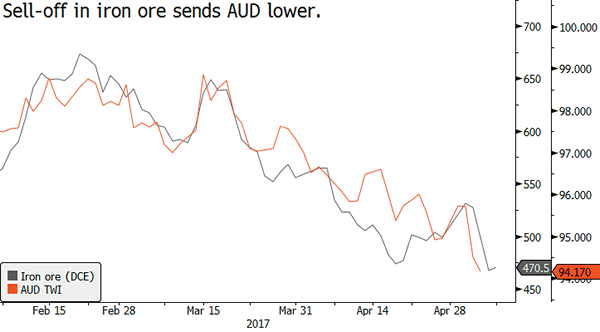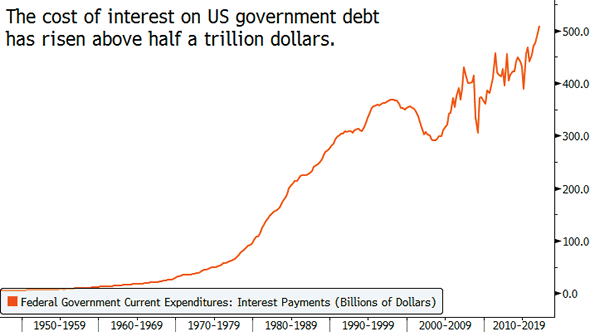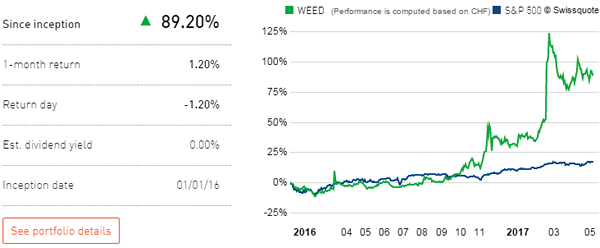- Long EM Asia – Peter Rosenstreich
- AUD In The Doldrums As Commodities Slide – Arnaud Masset
- Markets Are Very Confident About A Fed Rate Hike In June – Yann Quelenn
- Weed
Economics – Long EM Asia
Asia emerging markets asset have been benefiting from continual improvement of risk appetite and solid external and domestic fundamental data. Last week marginal correct was due to uncertainty around the French elections, weaknesses in commodity prices as China further tightening financial conditions. In addition the specter of seasonal selling in May weigh on investors mind. However, we suspect these issues are transitional and should fade in investors’ minds as conditions stabilize favorably. EM Asia should return to positive performance especially against the JPY which is challenged to hold investors’ attention as US interest rate rise.
KRW has borne the brunt of much external noise selling. Rising tension with North Korea, political scandal, fear of restrict trade policy, worries that relative growth rates would decline sent KRW lower. On 9th May South Korea is scheduled to holds its Presidential elections. Since there is no transition between governments, this will lower the current period of political uncertainty. The polls indicate that Moon Jae-in would bring the liberal party back into power after 10 years. A smooth political process will help regain confidence and support KRW moving forward.
Indonesia GDP growth improved marginally in 1Q 2017 rising to 5.01% y/y from 4.9% in 4Q, yet the read was slightly weaker than expected (5.1%). Despite solid export performance and government consumption growth remains sluggish. However, Bank of Indonesia provided some hawkish commentary, the outlook for tighter monetary policy seem unlikely. We anticipate the BI will continue to focus on supporting growth, capping inflations and managing IDR volatility.
While we don’t expected any proactive hikes, as growth remains suboptimal (yet sudden pickup could easily trigger a reexamination of this view), the threat of higher interest rate should provide IDR with additional fundamentals support.
Finally, in the Philippines headline inflations rise 3.4% in April (in-line with Bangko Sentrals current 2017 forecasts). Food inflations remained elevated at 4-2% from 4.0% in March. We remain focused on the potential upside in inflations especially form government promoted tax reforms. With growth and inflation trending positively we could see the BSP starting increase rates before EM Asia hiking cycle really kicks off. A strong reason to position yourself long PHP.

Economics – AUD In The Doldrums As Commodities Slide
The Australian dollar has been, by far, the worst performer last week among the G10 complex. The Aussie collapsed to 0.7368 against the greenback, the lowest level since January 11th. The free-fall of the Aussie is due to the combination of several factors ranging from disappointing economic data, central bank announcement to falling commodity prices.
Last Tuesday, the Reserve Bank of Australia held unchanged the official cash rate target at record low 1.50%. The decision was broadly anticipated by market participants. Therefore they focused on the tone of the statement as they tried to get some hint about the institution’s next move. The tone was slightly more positive than a month ago as Governor Lowe highlighted the positive trend in employment growth. However, the central bank reiterated its cautious stance as core inflation is still running low and has shown little sign of improvement recently: core gauge printed at 1.5% y/y versus 1.3% in the previous quarter, while headline inflation reached 2.1% y/y compared to 1.5% in the previous quarter. All in all, the RBA wants to avoid as much as possible to appear hawkish – mostly to prevent a sharp appreciation of the Aussie – even though it cannot turn a blind eye to the recent improvements, even minor ones
Secondly, the broad debasement of commodity prices – mostly crude oil and iron ore prices – weighted on exporters such as Australia. This move has to be seen within the context of tightening financial conditions in China amid a tougher bond market regulation. In China, the price of iron ore fell 14% over the last five days, amid concerns over weak demand. Iron ore futures for delivery in September on the Dalian Commodity Exchange ended the week at CNY 461.5 a metric ton.
Finally, the market is heavily positioned on the bullish side as net noncommercial positioning, reported by the CFTC, stands at around 39% of total open interest (as of April 25th). An unwinding of those long positions – which already started – may accelerated the Aussie’s debasement. AUD/USD has already broke all of its short-term supports as the market is trying to determine a bottom in the currency pair. The next key support can be found at 0.7145 (low from May 24th last year).

Title – Markets Are Confident About A Fed Rate Hike In June
The FOMC meeting was clearly the key FX event last Wednesday. The market got it right and priced in a no-rate hike. Markets already feel more confident for a rate increase at the next meeting in June. Markets’ estimates are around 100% at the moment. When looking carefully at the Fed meeting statement, we can notice that the US central bank is worried about the slowing in growth but believe it is going to be transitory.
If we assess more closely the data of the US economy, the jobs report were, in average, much better. Last Friday’s NFP printed above the consensus (211k vs 190k). It is nonetheless important to notice that March figure has been revised down to 79k from 98k. Other recent data were lacklustre (GDP and personal consumption in particular). The inflation target of 2% was beaten in February before falling again below this level. In March, industrial production also saw its biggest decline for the last two years.
We remain suspicious on Fed rate path tightening for this year as we believe that the state the US economy is overestimated. A few elements allow us to say so. For example, the number of bankruptcies in the US in 2017 is already higher than all bankruptcies in 2016. On top of that, the second-hand car market is collapsing as the losses on auto credit subprime have reached their highest level. Last but not least, 60% of Americans – according to a CNN poll – do not have a $500 emergency fund.
Out of this is why we maintain our bullish position on the EURUSD, despite political uncertainties in Europe. This should continue in our view as the Trump’s spending plans, tax reforms are going to cost a lot and the Federal government current interest payments have never been so high. Above 508 billion dollars for the first quarter of the year.

Themes Trading – Weed
Marijuana
Yes, we all know the jokes, but marijuana is big business in North America. US comedian Jimmy Kimmel stated that Colorado’s new state slogan is "Come for the legal marijuana, stay because you forgot to leave."
The North American market for weed is estimated to have grown to $53 billion in 2016. This includes legal recreational use, medical markets and the illegal trade. The legal North American marijuana market generated 2016 revenues of $6.9 billion, 34% higher than the 2015 total, largely as a result of explosive growth in adult consumer sales. There are currently 26 states plus the District of Columbia with laws broadly legalizing marijuana in some form (8 with legalization for recreational use), together with other states preparing to introduce legislation permitting marijuana use.
As of now, under federal law cannabis remains a controlled substance and illegal. For the time being, companies whose business is marijuana must obtain individual state licenses to operate and sell. This makes the evolution from small to medium-sized company and then national brand, which is critical for public listing, a challenge. However, there is a growing group of small cap stocks that have led the charge in this booming industry. To build a comprehensive, diversified portfolio, we have added cannabis producers and growers as well as biotechnology companies that have high profit potential (no pun intended) thanks to the legalization of marijuana. Please note that many of these stocks are high-risk and should be traded with caution due to illiquidity, low stock prices and a history of sharp reactions to news.













